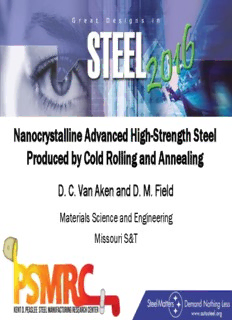
Nanocrystalline Advanced High-Strength Steel Produced by Cold Rolling and Annealing PDF
Preview Nanocrystalline Advanced High-Strength Steel Produced by Cold Rolling and Annealing
Nanocrystalline Advanced High-Strength Steel Produced by Cold Rolling and Annealing D. C. Van Aken and D. M. Field Materials Science and Engineering Missouri S&T Center launched July 1, 2013 •12 industrial members •$750,000 current research •7 funded research projects −Refractory technology (2) −Deformation processing (1) −Casting technology (1) −Steel alloy development (1) −Foundry technology 3 3rd Generation Advanced High-Strength Steel • NSF / DOE funded work on Nano Acicular Duplex Steels − Meghan McGrath Ph.D. (2012) − Krista Limmer Ph.D. (2014) • PSMRC funded work on Two-stage TRIP AHSS − Scott Pisarik M.S. (2014) − Dan Field Ph.D. (2018) • Industrial partners: Nucor, AK Steel, USS and ArcelorMittal 3rd Generation Property Space • Survey work to determine chemistry & properties • Batch Annealed material promising route to 3rd Gen AHSS • All alloys produced and tested are shown What is Two-Stage TRIP? = γ-austenite = ε-martensite = α-martensite Two-Stage Grain Refinement Y Y X X Athermal transformation • ε-martensite segments the austenite • 6 variants of a-martensite segments the ε-martensite Carbon’s Effect Upon ε- M S Increased C content • decreases the martensite start temperature for ε- martensite Carbon content should • be kept below 0.2 wt% to ensure TRIP effect at room temperature Prefer Mse >Msa • Koyama et al., Mater. Sci. Eng. A vol. 528, (2011) 7310-7316. Thermodynamic Modeling • Gibbs free energy for the γ→ε phase transformation can be expressed using a regular solution model • Stacking fault energy SFE describes ε-martensite stability relative to γ-austenite • n=4 for e-martensite • Reported SFE are RT calculated Thermodynamic Model for M ε Temperature S S&T Composition limits in wt.% of the 90 alloys from literature M ε Map for FeMnSiAl Alloys S • Carbon and nitrogen fixed at 0.07 wt.% and 0.017 wt.% • n=4 in SFE calculation
Description: